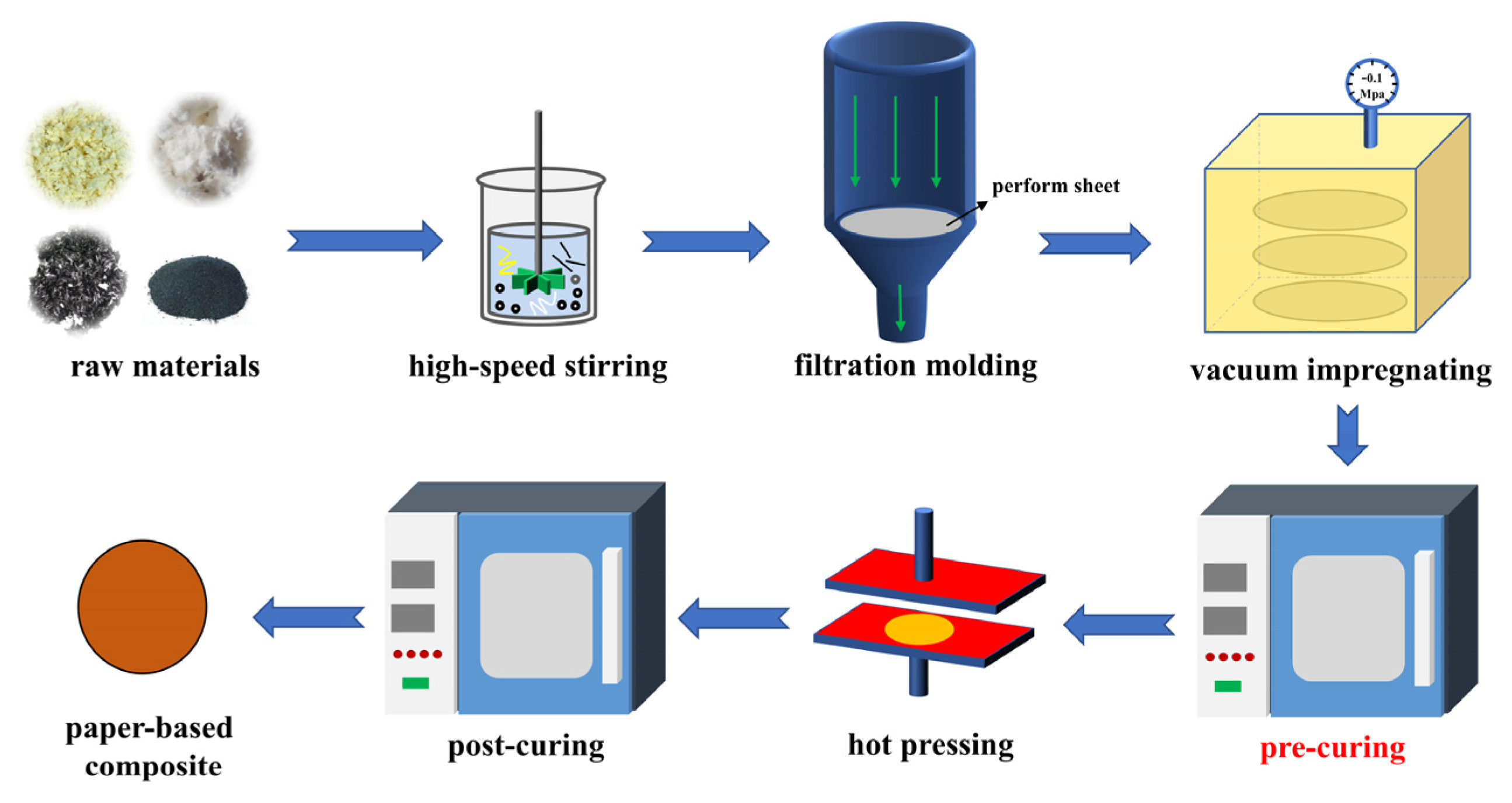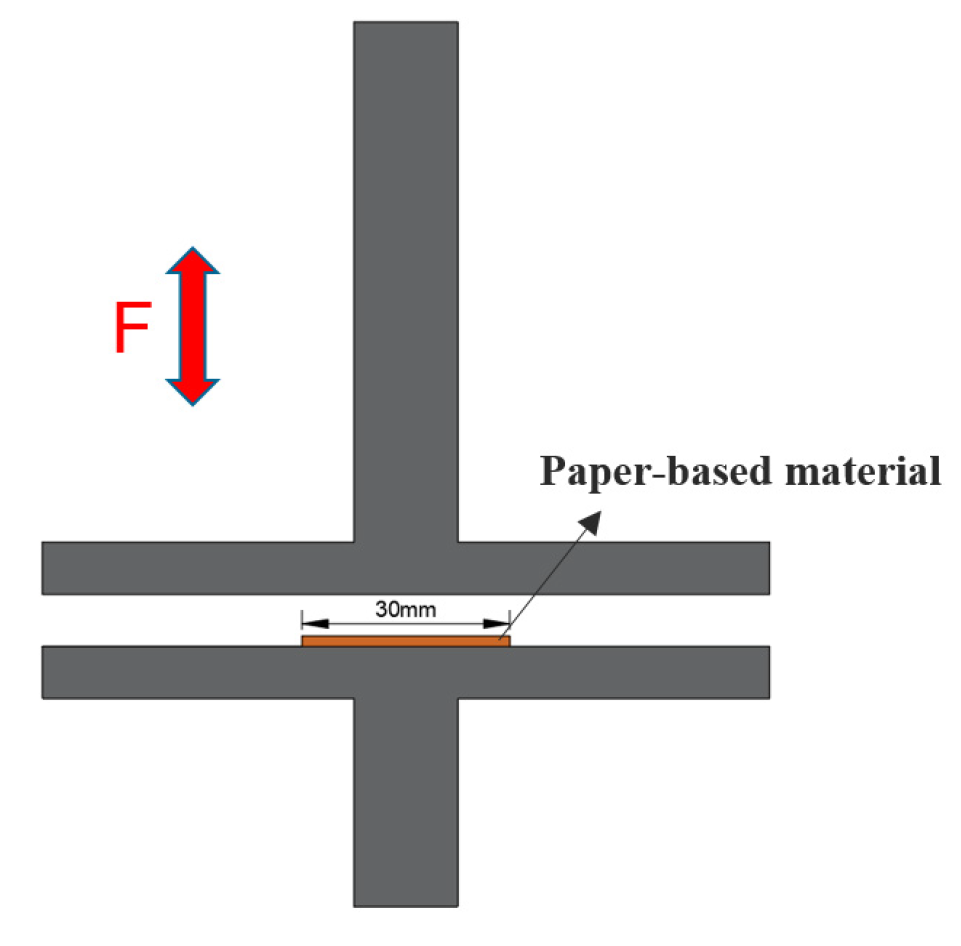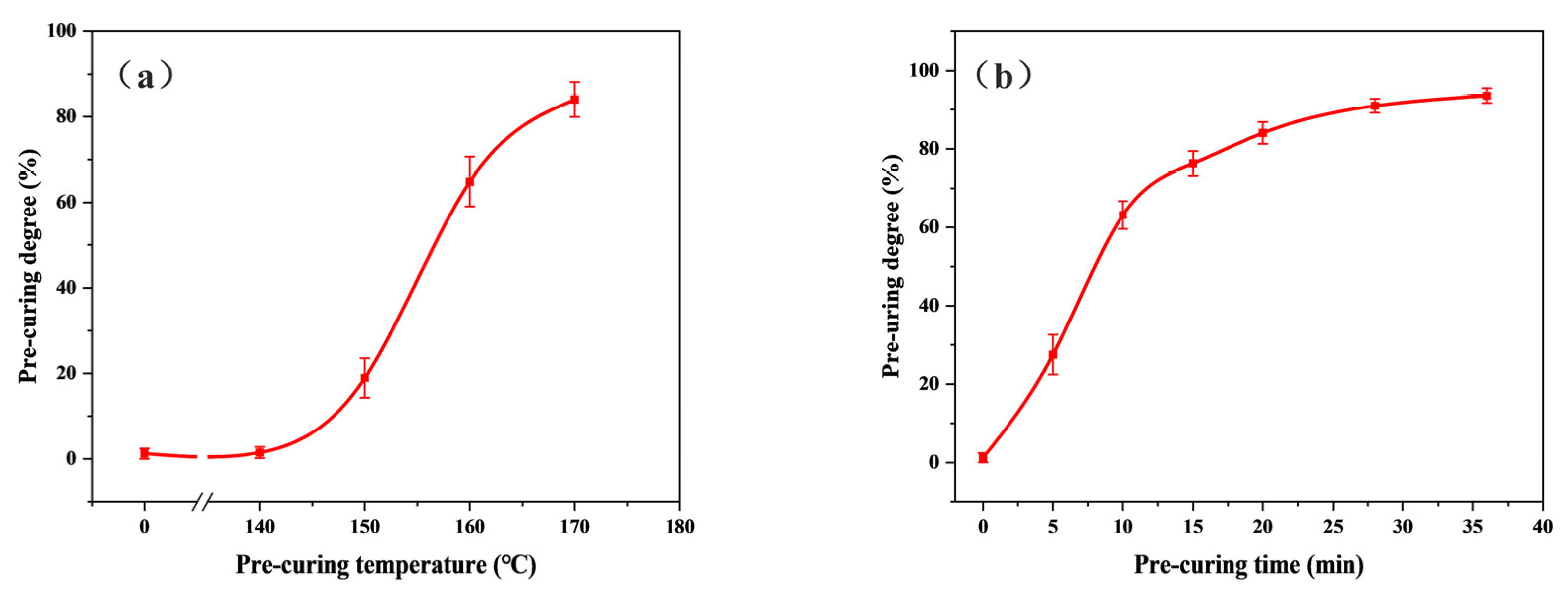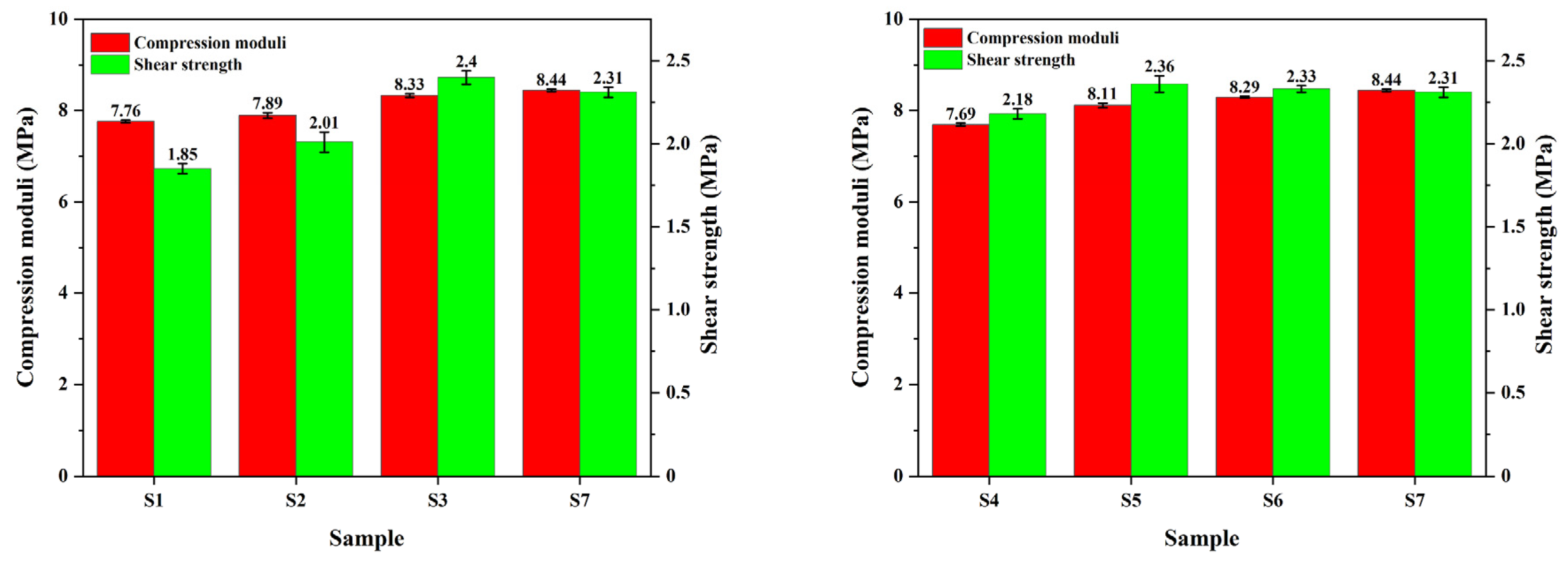Effects of Pre-Curing on the Structure and Properties of Paper-Based Materials
Abstract
:1. Introduction
2. Materials and Methods
2.1. Raw Material
2.2. Sample Preparation
2.3. Testing Method and Equipment
3. Results and Discussion
3.1. Curing Reactions of CMPR
3.2. Effects of Pre-Curing Conditions on the Pre-Curing Degree of Materials
3.3. Effects of Pre-Curing on the Morphology of Materials before and after Hot-Pressing
3.4. Effects of Pre-Curing on the Mechanical Properties of Materials
3.5. Effects of Pre-Curing on the Dynamic Mechanical Properties of Materials
4. Conclusions
Author Contributions
Funding
Institutional Review Board Statement
Data Availability Statement
Acknowledgments
Conflicts of Interest
References
- Fei, J.; Li, H.; Fu, Y.; Qi, L.; Zhang, Y. Effect of phenolic resin content on performance of carbon fiber reinforced paper-based friction material. Wear 2010, 269, 534–540. [Google Scholar] [CrossRef]
- Fei, J.; Li, H.; Qi, L.; Fu, Y.; Li, X. Carbon-Fiber Reinforced Paper-Based Friction Material: Study on Friction Stability as a Function of Operating Variables. J. Tribol. 2008, 130, 4. [Google Scholar] [CrossRef]
- Kimura, Y.; Otani, C. Contact and wear of paper-based friction materials for oil-immersed clutches—Wear model for composite materials. Tribol. Int. 2005, 38, 943–950. [Google Scholar] [CrossRef]
- Bijwe, J.; Nidhi; Majumdar, N.; Satapathy, B.K. Influence of modified phenolic resins on the fade and recovery behavior of friction materials. Wear 2005, 259, 1068–1078. [Google Scholar] [CrossRef]
- Li, W.; Huang, J.; Fei, J.; Wang, W.; Cao, L. Effects of Modified-Phenolic on the Tribological Properties of Carbon Fiber Reinforced Phenolic Friction Materials. Mater. Sci. Forum. 2016, 852, 698–703. [Google Scholar] [CrossRef]
- ÖztürkS, B.; Öztürk, S. Effects of Resin Type and Fiber Length on the Mechanical and Tribological Properties of Brake Friction Materials. Tribol. Lett. 2011, 42, 339–350. [Google Scholar] [CrossRef]
- Kim, Y.; Cho, M.; Kim, S.; Jang, H. The effect of phenolic resin, potassium titanate, and CNSL on the tribological properties of brake friction materials. Wear 2008, 264, 204–210. [Google Scholar] [CrossRef]
- Tian, H.; Fei, J.; Li, C.; Qi, L.; Cai, X.; Li, B.; Fu, Y. Significant improvement of thermal and tribological performance with polyimide as the matrix of paper-based friction materials. Polym. Compos. 2022, 43, 2303–2317. [Google Scholar] [CrossRef]
- Lu, J.; Li, Y.; Wang, Y.; Fu, Y. Effect of LNBR Content on the Properties of the Carbon Fiber–Reinforced Paper-Based Friction Materials. Tribol. T. 2019, 62, 537–547. [Google Scholar] [CrossRef]
- Lu, J.; Li, Y.; Wang, Y.; Fu, Y. Effect of pre-impregnated organosilicon layer on friction and wear properties of paper-based friction materials. Wear 2018, 416, 6–13. [Google Scholar] [CrossRef]
- Zhang, D.; Li, C.; Cao, Y.; Lu, Z.; Cui, Q. Tribological Performance Comparison and Analysis on Friction Material: Four Modified Phenolic (PF) Resins. Key Eng. Mater. 2016, 693, 653–661. [Google Scholar] [CrossRef]
- Thébault, M.; Kandelbauer, A.; Müller, U.; Zikulnig-Rusch, E.; Lammer, H. Factors influencing the processing and technological properties of laminates based on phenolic resin impregnated papers. Eur. J. Wood. Wood. Prod. 2017, 75, 785–806. [Google Scholar] [CrossRef]
- Li, C.; Fei, J.; Zhou, E.; Lu, R.; Cai, X.; Fu, Y.; Li, H. Optimization of pore structure and wet tribological properties of paper-based friction materials using chemical foaming technology. Friction 2022, 10, 18. [Google Scholar] [CrossRef]
- Li, C.; Fu, Y.; Wang, B.; Zhang, W.; Bai, Y.; Zhang, L.; Qi, L. Effect of pore structure on mechanical and tribological properties of paper-based friction materials. Tribol. Int. 2020, 148, 106307. [Google Scholar] [CrossRef]
- Muc, A.; Romanowicz, P.; Chwal, M. Description of the Resin Curing Process—Formulation and Optimization. Polymers 2019, 11, 127. [Google Scholar] [CrossRef] [Green Version]
- Wang, C.; Wang, R.; Wang, Y.; Fu, Y. Study on Curing Process of Resin Nanocomposites Key. Eng. Mater. 2012, 501, 349–354. [Google Scholar]
- Zhang, C.; Zhang, G.; Xu, J.; Shi, X.; Wang, X. Review of curing deformation control methods for carbon fiber reinforced resin composites. Polym. Compos. 2022, 43, 3350–3370. [Google Scholar] [CrossRef]
- Pablo, M.P.; Laura, C.; Raúl, O.; Maite, I.; Isabel, C.A. Cure kinetics of a composite friction material with phenolic resin/rubber compounds as organic binder. Plast. Rubber. Compos. 2022, 51, 507–519. [Google Scholar]
- Nidhi; Bijwe, J.; Mazumdar, N. Influence of amount and modification of resin on fade and recovery behavior of non-asbestos organic (NAO) friction materials. Tribol. Lett. 2006, 23, 215–222. [Google Scholar] [CrossRef]
- Alonso, M.; Oliet, M.; García, J.; Rodríguez, F.; Echeverría, J. Master curve and time–temperature–transformation cure diagram of lignin–phenolic and phenolic resol resins. J. Appl. Polym. Sci. 2007, 103, 3362–3369. [Google Scholar] [CrossRef]
- Hirano, K.; Asami, M. Phenolic resins—100 years of progress and their future. React. Funct. Polym. 2013, 73, 256–269. [Google Scholar] [CrossRef]
- Zheng, Y.; Jiang, Z.; Sun, Z.; Ren, H. Effect of microwave-assisted curing on bamboo glue strength: Bonded by thermosetting phenolic resin. Constr. Build. Mater. 2014, 68, 320–325. [Google Scholar] [CrossRef]
- Mohan, P. A Critical Review: The Modification, Properties, and Applications of Epoxy Resins. Polym-Plast. Technol. 2013, 52, 107–125. [Google Scholar] [CrossRef]
- Koranteng, K.; Li, H.; Ma, B.; Ma, C. Coefficient of friction and wear rate of paper-based composite friction material against 65Mn steel. Proc. Inst. Mech. Eng. Part J J. Eng. Tribol. 2021, 235, 544–550. [Google Scholar] [CrossRef]
- Rahmani, N.; Willard, B.; Lease, K.; Legesse, E.T.; Soltani, S.A.; Keshavanarayana, S. The effect of post cure temperature on fiber/matrix adhesion of T650/Cycom 5320-1 using the micro-droplet technique. Polym. Test. 2015, 46, 14–20. [Google Scholar] [CrossRef]
- Park, H.; Koo-Hyun, C. Effect of Normal Force and Temperature on Tribological Properties of Wet Clutch Friction Material. Tribol. Lubr. 2019, 35, 30–36. [Google Scholar]
- Fujii, T.; Tohgo, K.; Wang, Y.; Shibata, J.; Shimamura, Y.; Katayama, N.; Ito, Y. Fatigue strength of a paper-based friction material under shear–compressive loading. Strength. Fract. Comp. 2011, 7, 185–193. [Google Scholar] [CrossRef]
- Matsumoto, T. A Study of the Durability of a Paper—Based Friction Material Influenced by Porosity. J. Tribol-T. Asme. 1995, 117, 272. [Google Scholar] [CrossRef]
- Bressan, J.D.; Genint, G.; Williams, J.A. The Influence of Pressure, Boundary Film Shear Strength and Elasticity on the Friction between a Hard Asperity and a Deforming Softer Surface. Tribol. Ser. 1999, 36, 79–90. [Google Scholar]
- Sendler, E.; Greening, B.; Greening, C. Continued Study of the Effect of Humidity Levels on the Compressibility of Automotive Brake Friction Materials. SAE. Tech. Pap. 2022, 1, 1164. [Google Scholar]
- Chiba, N.; Kano, M.; Inoue, M. Mechanism of compression fatigue of wet friction materials. JSAE Rev. 2001, 22, 169–174. [Google Scholar] [CrossRef]
- Saba, N.; Jawaid, M.; Alothman, O.Y.; Paridah, M.T. A review on dynamic mechanical properties of natural fibre reinforced polymer composites. Constr. Build. Mater. 2016, 106, 149–159. [Google Scholar] [CrossRef]















| Samples | Pre-Curing Temperature/°C | Pre-Curing Time/min |
|---|---|---|
| S1 | 140 | 20 |
| S2 | 150 | 20 |
| S3 | 160 | 20 |
| S4 | 170 | 5 |
| S5 | 170 | 10 |
| S6 | 170 | 15 |
| S7 | 170 | 20 |
Disclaimer/Publisher’s Note: The statements, opinions and data contained in all publications are solely those of the individual author(s) and contributor(s) and not of MDPI and/or the editor(s). MDPI and/or the editor(s) disclaim responsibility for any injury to people or property resulting from any ideas, methods, instructions or products referred to in the content. |
© 2023 by the authors. Licensee MDPI, Basel, Switzerland. This article is an open access article distributed under the terms and conditions of the Creative Commons Attribution (CC BY) license (https://creativecommons.org/licenses/by/4.0/).
Share and Cite
Lin, M.; Zhou, W.; Yao, Y.; Chen, J.; Zhang, C. Effects of Pre-Curing on the Structure and Properties of Paper-Based Materials. Polymers 2023, 15, 2702. https://doi.org/10.3390/polym15122702
Lin M, Zhou W, Yao Y, Chen J, Zhang C. Effects of Pre-Curing on the Structure and Properties of Paper-Based Materials. Polymers. 2023; 15(12):2702. https://doi.org/10.3390/polym15122702
Chicago/Turabian StyleLin, Mingcen, Wenling Zhou, Ye Yao, Jingxiang Chen, and Chunhui Zhang. 2023. "Effects of Pre-Curing on the Structure and Properties of Paper-Based Materials" Polymers 15, no. 12: 2702. https://doi.org/10.3390/polym15122702
APA StyleLin, M., Zhou, W., Yao, Y., Chen, J., & Zhang, C. (2023). Effects of Pre-Curing on the Structure and Properties of Paper-Based Materials. Polymers, 15(12), 2702. https://doi.org/10.3390/polym15122702





